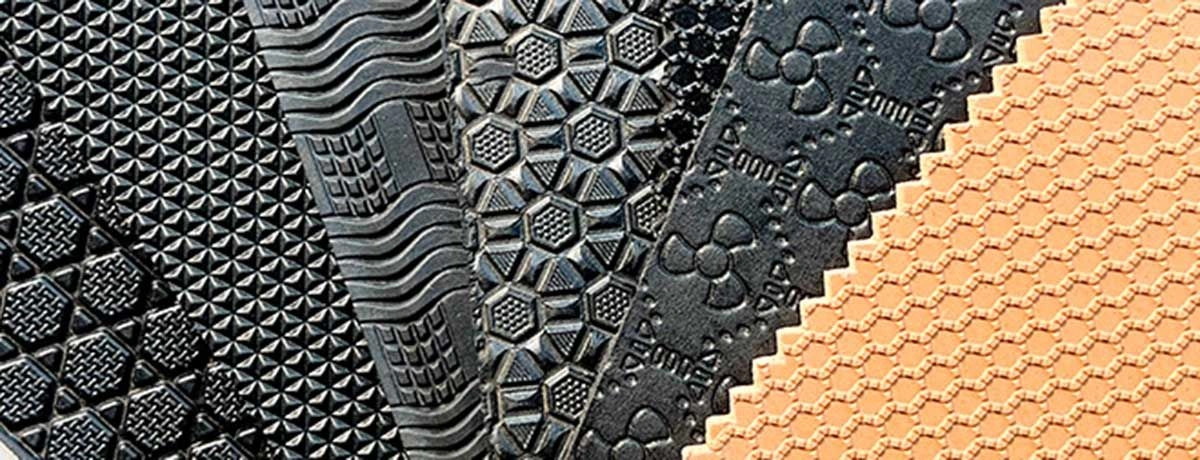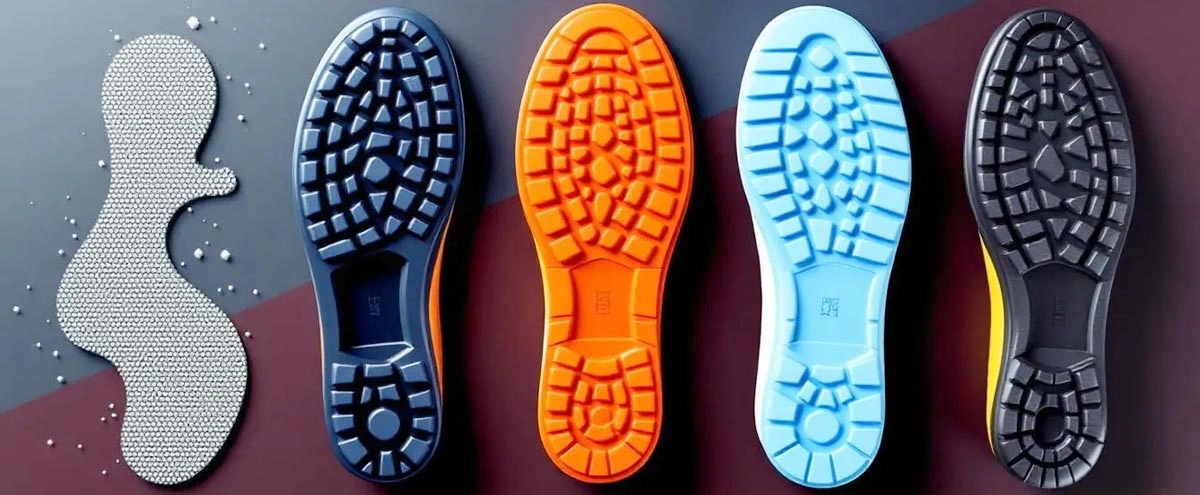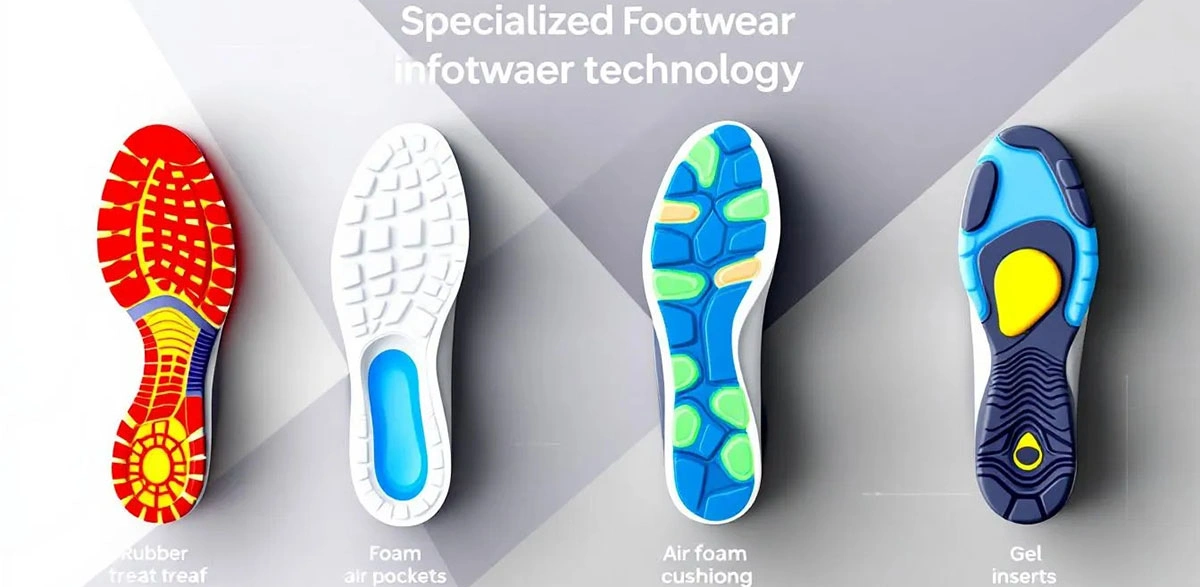Best Shoe Sole Material for Optimal Comfort and Durability

Looking for the best shoe sole material? You’re in the right place. Whether you need durability, comfort, or slip resistance, each material has its benefits. In this guide, we’ll break down popular options like rubber, EVA, leather, PU, Dainite, and crepe. By the end, you’ll know exactly which material fits your needs.
Key Takeaways
-
Different shoe sole materials, including rubber, EVA, leather, PU, Dainite, and crepe, each offer distinct benefits suited to various activities and preferences.
-
Rubber soles are highly durable and slip-resistant, making them ideal for demanding environments, while EVA soles provide superior cushioning and flexibility, catering to athletic and casual footwear.
-
Understanding specific care and maintenance requirements for each sole material can significantly prolong the lifespan and performance of your footwear.
Exploring Different Shoe Sole Materials

Shoe sole materials are as diverse as the footwear they support. From the ruggedness of rubber soles to the classic appeal of leather soles, each midsole material offers unique benefits tailored to specific activities and preferences. Knowing these differences helps in choosing the ideal sole material for your needs and lifestyle.
We will examine the characteristics, advantages, and ideal applications of various sole materials, including:
-
Rubber
-
EVA
-
Leather
-
PU
-
Dainite
-
Crepe Each material offers distinct strengths, catering to specific types of footwear and user needs.
By the end, you’ll have the knowledge to select the perfect sole material for your shoes.
Rubber Soles
Rubber soles are the cornerstone of durability and traction in footwear. Known for being the toughest shoe sole material, rubber provides exceptional resistance to abrasion and wear, making it ideal for various environments and activities. Whether you’re navigating wet, uneven terrain or simply seeking a reliable everyday shoe, rubber soles offer a stable foundation with excellent slip resistance.
Rubber soles have the following characteristics:
-
Water-resistant, making them perfect for outdoor adventures and work boots
-
Tend to be heavier compared to other materials
-
Less breathable, which can affect comfort in hot climates
Despite these minor drawbacks, the unmatched wear resistance and outdoor versatility of abrasion resistant rubber soles make them a top choice for everyday use for those seeking long-lasting, reliable rubber sole footwear that can be worn with water resistance.
EVA Soles
EVA, which stands for ethylene vinyl acetate, is known for:
-
Its lightweight nature
-
Shock-absorbing properties
-
Superior cushioning, making it a favorite for athletic shoes and running footwear
-
Flexibility and comfort that enhance performance and reduce the impact on the feet, crucial for high-impact activities
A significant advantage of EVA soles is their lightweight design, which reduces the overall shoe weight and enhances movement. However, they may not be as durable as rubber soles and can wear out more quickly under heavy use. Despite this, the comfort and flexibility offered by EVA soles make them an excellent choice for casual and athletic footwear.
Leather Soles
Leather soles bring a touch of tradition and elegance to footwear. Known for their ability to mold to the contours of the feet, leather soles provide a personalized fit that enhances comfort over time. They are a classic choice for formal footwear, offering a polished and sophisticated appearance, especially when considering the various types of soles available.
However, leather soles require regular maintenance to keep them in good condition and to prevent cracking. They can be slippery and are not ideal for wet weather, which limits their versatility.
Despite these challenges, the timeless appeal and durability of leather soles make them a top choice for dress shoes and formal occasions.
PU Soles
Polyurethane (PU) soles are known for their exceptional durability and resistance to abrasion, oil, and chemicals. These characteristics make PU soles a popular choice for work boots and everyday wear, where durability is paramount. The lightweight nature of PU soles also contributes to their comfort, making them suitable for prolonged use.
While PU soles are highly durable, they tend to be less flexible compared to other materials, which can affect comfort for activities requiring significant foot movement. Nonetheless, the durability and resistance of PU soles make them a reliable choice for demanding environments and daily wear.
Dainite Soles
Dainite soles are distinguished by their studded pattern, which enhances traction and provides slip resistance, making them versatile for various types of footwear. These soles are known for their durability and reliability in different weather conditions, making them ideal for outdoor use.
However, Dainite soles offer less flexibility compared to other materials, which can limit their comfort for extended wear. Despite this, the excellent performance and slip resistance of Dainite soles make them a practical choice for adventure enthusiasts and those seeking reliable outdoor footwear.
Crepe Soles
Crepe soles, made from natural rubber, are valued for their comfort and flexibility. These soles provide a unique feel and are ideal for casual wear where comfort is a priority. The natural rubber composition of crepe soles also contributes to their eco-friendliness.
One downside of crepe soles is their tendency to wear out more quickly compared to other materials, making them less suitable for long-term use. Despite this, the comfort and flexibility offered by crepe soles make them a popular choice for casual footwear.
Comparative Analysis of Sole Materials
Different sole materials play a crucial role in determining the overall performance of footwear. Factors to consider when choosing the right sole material include:
-
Durability
-
Comfort
-
Traction
-
Flexibility
-
Environmental impact
-
Cost-effectiveness
Each material has its unique strengths and weaknesses, and understanding these differences can make all the difference for making an informed decision about synthetic material.
Next, we will compare the performance of various sole materials based on specific criteria:
-
Durability
-
Cushioning
-
Slip resistance
-
Weight
-
Environmental impact
-
Cost-effectiveness
This comparative analysis will help you understand how each material measures up in these areas, ensuring you choose the best sole material for your needs.
Durability and Longevity
When it comes to durability, rubber soles stand out as the most robust option, providing excellent resistance to wear and tear. This makes them ideal for work boots and outdoor footwear, where longevity is crucial. Regular maintenance, such as cleaning and protecting the soles from harsh conditions, can further extend their lifespan.
In contrast, EVA and crepe soles, while comfortable, tend to wear out faster and are less durable than rubber or PU soles. This makes them suitable for lighter, casual activities rather than heavy-duty use.
For long-lasting footwear, rubber and PU materials offer the best durability and longevity.
Comfort and Cushioning
Comfort is a critical factor in choosing the right sole material. EVA soles are renowned for their superior cushioning, providing excellent shock absorption and reducing impact on the feet. This makes them ideal for running shoes and activities that require significant foot movement.
PU soles also contribute to comfort with their cushioning properties, making them suitable for everyday wear. Leather soles, while less cushioned, offer a personalized fit that enhances comfort over time. Comfort depends on selecting the right sole material based on the wearer’s needs and activities.
Traction and Slip Resistance
Traction and slip resistance are vital for safety and performance in various conditions. Rubber soles excel in this regard, offering superior grip on different surfaces and in wet or uneven conditions. This makes them a popular choice for work boots, hiking boots, athletic shoes, and slip resistant shoes.
Dainite soles, with their studded pattern, also provide excellent slip resistance, making them suitable for outdoor activities and wet conditions. Leather soles, while elegant, may not offer the same level of traction, making them less ideal for slippery environments.
Choosing the correct sole material for reliable traction ensures safety and stability in various conditions.
Weight and Flexibility
Weight and flexibility significantly impact the comfort and performance of footwear. Rubber soles offer a good balance of weight and flexibility, providing stability without compromising ease of movement. This makes them suitable for various activities, from casual wear to outdoor adventures. However, overly rigid materials can hinder movement and comfort.
EVA soles, being lighter and more flexible, enhance comfort and movement, especially in athletic shoes and casual sandals. However, they may not provide the same level of durability as rubber soles. Balancing weight, flexibility, and durability is crucial for selecting the right sole material.
Environmental Impact
Eco-conscious consumers increasingly consider the environmental impact of their footwear. Crepe soles, made from natural rubber, offer an eco-friendly option due to the biodegradable nature of the material. Recycled rubber is also gaining popularity for its balance of performance and sustainability.
The production of conventional shoe soles often generates significant waste, contributing to landfill overflow. Opting for materials like TPR and recycled rubber with a lower environmental footprint can reduce the ecological impact of footwear.
This consideration is crucial for those looking to make more sustainable choices in their footwear.
Cost Effectiveness
Cost-effectiveness is an important factor when selecting shoe soles. While materials like rubber and PU may have a higher upfront cost, their durability and longevity make them a wise investment in the long run. Rubber soles, in particular, offer excellent long-term value due to their durability and resistance to wear.
On the other hand, EVA soles are generally cheaper upfront but may result in higher long-term costs due to their shorter lifespan. Evaluating both initial and long-term costs of sole materials is crucial for determining overall value and making cost-effective footwear choices.
Specialized Sole Types for Specific Footwear

Choosing the right sole material often depends on the specific activities and environments in which the footwear will be used. Whether you’re running, working, or attending a formal event, selecting the appropriate sole material can significantly enhance performance and comfort.
We will explore specialized sole types for athletic shoes, work boots, and dress shoes, highlighting the unique requirements and ideal materials for each type. By understanding these specific needs, you can ensure that your footwear provides the best support and performance for your activities.
Athletic Shoes
Athletic shoes require soles that offer lightweight comfort and flexibility to enhance performance. EVA soles are commonly used in running shoes and casual sandals for their shock-absorbing properties and lightweight nature. These soles reduce the overall weight of the shoe, making them ideal for activities that require quick, agile movements.
Rubber soles offer superior durability but their weight may not suit all athletic activities. The flexibility and comfort of EVA soles make them a preferred choice for athletes and casual wearers alike.
Work Boots
Work boots demand durability and slip resistance to withstand the rigors of daily wear. Rubber outsoles are widely used in work boots due to their flexibility and excellent resistance to wear and tear. These soles provide the necessary stability and protection for various outdoor tasks.
Different types of work boots, such as hiker-style and logger boots, feature specialized outsoles designed for specific environments and tasks. For example, wedge outsoles offer even weight distribution for flat surfaces, while 90-degree heel work boot enhances stability on uneven terrain.
Selecting the right sole material for work boots ensures safety and long-lasting performance.
Dress Shoes
For dress shoes, leather soles are often preferred for their classic appearance and ability to provide a polished finish. Leather soles not only offer an elegant look but also mold to the contours of your feet over time, ensuring a personalized fit and enhanced comfort.
For those who require additional traction without compromising on style, some dress shoes incorporate rubber soles that mimic the appearance of leather while providing better grip on various surfaces. Selecting the right sole material for dress shoes can balance aesthetics, comfort, and functionality, making your favorite pair suitable for formal occasions and everyday wear.
Maintenance Tips for Different Sole Materials
Proper shoe sole maintenance can significantly prolong their lifespan and ensure optimal performance. Regular cleaning and protection are essential for all types of sole materials. Understanding the specific care requirements for each material can help you maintain the integrity and appearance of your footwear.
We will provide detailed tips on cleaning and protecting different sole materials, along with advice on avoiding damage. Following these guidelines will help keep your shoes in excellent condition and extend their usability.
Cleaning and Protection
For rubber soles:
-
Use a damp cloth to wipe off dirt.
-
Use a soft brush for deep cleaning, ensuring they remain flexible and durable.
-
Apply a rubber protectant to help maintain their condition.
Leather soles should be cleaned with a soft, damp cloth and treated with a suitable leather conditioner to prevent cracking and maintain their integrity.
EVA soles, being sensitive to extreme heat, should be cleaned with mild soap and water and allowed to air dry. PU soles should be protected from prolonged exposure to sunlight, while Dainite soles benefit from regular brushing and the use of specialized sole cleaners.
Crepe soles require regular brushing and should be stored in a cool, dry place to avoid excessive moisture.
Avoiding Damage
Avoiding damage to shoe soles is crucial for maintaining comfort and prolonging the life of your footwear. Excessive heat can weaken and deform shoe soles, reducing their lifespan. Proper moisture protection is also essential, especially for materials like leather that are sensitive to water.
To prevent damage from abrasive surfaces, choose shoes with protective soles designed for rugged terrain. Regular maintenance routines, including cleaning and conditioning, can significantly extend the life of your footwear and ensure they remain comfortable and effective.
Choosing the Right Sole Material for Your Needs
Choosing the right sole material depends on your specific activities, preferences, and the environments in which you will be using your footwear. EVA soles are ideal for leisure activities due to their lightweight and flexible nature. Rubber soles, on the other hand, offer excellent durability and slip resistance, making them suitable for more demanding conditions.
When comparing rubber and EVA soles, consider factors such as:
-
Performance
-
Comfort
-
Lifespan
-
Initial costs
EVA soles might have a lower initial cost. However, rubber soles offer greater long-term value because they are more durable. By weighing the initial costs against the expected lifespan and usage patterns, you can make an informed decision that meets your needs.
Wholesale Order
For manufacturers, importers, and distributors looking to source high-quality shoe sole materials, MH offers a wide range of options, including EVA, TPR, rubber, PU leather, and more. As a professional wholesale supplier, MH provides competitive factory prices and customized options to meet your specific requirements.
With a strong production capacity and global shipping to over 150 countries, MH ensures fast delivery and reliable service. Whether you need materials for sports shoes, casual shoes, work boots, or sandals, MH is your one-stop supplier for all your footwear material needs.
Summary
In conclusion, the choice of shoe sole material plays a pivotal role in determining the comfort, durability, and overall performance of your footwear. From the rugged durability of rubber soles to the lightweight comfort of EVA soles, each material offers unique benefits tailored to specific activities and preferences. Understanding the strengths and drawbacks of each material can help you make an informed decision that aligns with your lifestyle and needs.
By considering factors such as durability, comfort, traction, environmental impact, and cost-effectiveness, you can select the right sole material that provides the best support and performance for your activities. Whether you’re an athlete, a worker, or someone who values style and comfort, the right sole material ensures that every step you take is a step in the right direction.
Frequently Asked Questions
What are the most durable shoe sole materials?
Rubber and polyurethane (PU) soles are recognized for their exceptional durability and wear resistance, making them ideal choices for longevity in footwear. Selecting shoes with these materials ensures enhanced durability over time.
Which sole material is best for running shoes?
EVA soles are the best material for running shoes because they are lightweight and provide excellent shock absorption, enhancing comfort and performance.
How can I maintain leather soles?
To maintain leather soles, clean them regularly with a soft, damp cloth and apply a suitable leather conditioner to prevent cracking and ensure durability. This simple routine will help preserve the integrity of your leather soles.
What are the environmental benefits of crepe soles?
Crepe soles offer significant environmental benefits as they are made from natural rubber, which is biodegradable. This contributes to reducing plastic waste and promotes sustainability in footwear.
Where can I order shoe sole materials in bulk?
You can order shoe sole materials in bulk from MH, which offers a variety of options at competitive prices with global shipping.
Contact MH
MH offers shoe sole materials. Please contact us for more details or inquiries. We're here to help!


